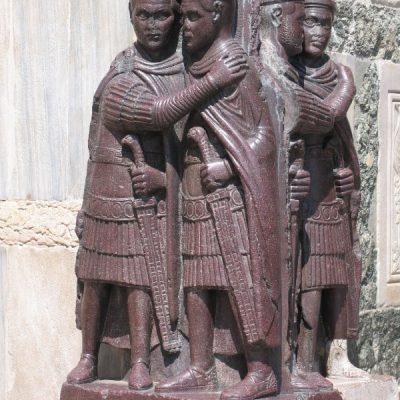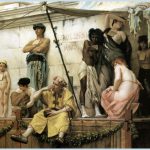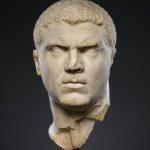Chapters
The Edict of Diocletian on Maximum Prices from 301 CE, known as Edictum Diocletiani et Collegarum de Pretiis Rerum Venalium, was intended to combat the progressive inflation in the Roman Empire by setting maximum prices on more than 1,400 products, slaves or services. The edict has survived to our times partly due to fragments of inscriptions (in Greek and Latin) on stone slabs found mainly in the eastern territories of the Empire, in 42 places.
Background of events
After the death of Alexander Severus in 235 CE, the last member of the Syrian dynasty, there was an economic and political crisis. It was known as the “Third Century Crisis” and lasted until Diocletian came to rule in 284 CE. At that time, the Roman Empire, constantly destabilized by internal struggles for power, had to defend its borders against attacks by neighbouring peoples and states. The need to defend the borders against the invasions of the Germanic tribes and the Persian army forced the emperors to over-expand their army, the cost of which increased and the Roman economy was unable to bear them.
Tetrarchy
Emperor Diocletian learned from the experience of previous decades and carried out a thorough reform of the Roman state. By focusing first on political stabilization, he realized that one person could no longer manage such a vast territory. It was not possible to react quickly and effectively in specific situations that occurred at its distant ends. So he introduced what he called the tetrarchy.
The emperor appointed a co-ruler with the title of Augustus and entrusted him with the management of the western part of the state – he entrusted this position to Maximian. Diocletian remained in the East but retained sovereignty over all the rest. Each Augustus found a deputy with the title of Caesar to help him; Diocletian chose Galerius, and Maximian chose Constantius. The emperor assumed that after twenty years of rule, Augustus would voluntarily relinquish power and the Caesars would take their place. They will appoint new Caesars, who will also become Augustus in the future, which was to be continued. However, this system turned out to be utopian, because after the abdication of Diocletian and his counterpart in the West, new civil wars broke out.
Monetary and economic reform
The division of power in the Empire caused a progressive bureaucratization, which required more and more financial outlays. The four seats of the emperors: Nicomedia (Diocletian), Milan (Maximian), Serdica, later Thessalonika (Galerius), Trier (Constantius) required a sufficient number of officials to be served. In order to obtain more funds, the emperors imposed enormous fiscal burdens on the population and supplemented the shortages in the treasury by the so-called “Spoiling the coin”, ie circulating a coin which, instead of precious metals, contained a large admixture of base metals. Thus, the denarius – the basic Roman coin – originally had 4.5 g of silver; during the reign of Nero, the amount decreased to 3.8 g; and by the end of the 3rd century CE. The denarius was already in practice a copper coin with a small amount of silver. The “spoilage of the coin” over the centuries led to hyperinflation, which became the main problem of the Roman state in the 3rd century CE.
After the stabilization of the rule and political situation of Diocletian in the 90s of the third century CE made attempts to save the monetary system. The ruler tried to strengthen confidence in the coin by, inter alia, ceasing to use the current denarius and replacing it with another silver coin – argentus (literally “silver”) – which referred to the denarius of Nero in the amount of the metal.
However, this did not lead to any visible improvement in the situation. Diocletian with the expansion of bureaucracy, which resulted from the appointment of three co-ordinates and the implementation of subsequent construction programs, including in Nicomedia, was unable to find savings. Therefore, at the end of 301 CE introduced an edict on maximum prices. One of the ancient sources – Lactantius – speaks very critically about this idea, believing that it contributed to the destruction of trade and bloodshed1. We do not know if the blood was shed because of the execution of disobedient citizens or if it resulted from social problems. According to Lactantius, Diocletian first caused a price increase and then was unable to fight it. It should be noted, however, that Lactantius was a Christian and his treatise was mainly aimed at slandering Diocletian, due to his dislike of Christ’s followers. An excerpt from the work is great proof of this:
While Diocletian, that author of ill, and deviser of misery, was ruining all things, he could not withhold his insults, not even against God. This man, by avarice partly, and partly by timid counsels, overturned the Roman empire. For he made choice of three persons to share the government with him; and thus, the empire having been quartered, armies were multiplied, and each of the four princes strove to maintain a much more considerable military force than any sole emperor had done in times past. There began to be fewer men who paid taxes than there were who received wages; so that the means of the husbandmen being exhausted by enormous impositions, the farms were abandoned, cultivated grounds became woodland, and universal dismay prevailed. Besides, the provinces were divided into minute portions, and many presidents and a multitude of inferior officers lay heavy on each territory, and almost on each city. There were also many stewards of different degrees and deputies of presidents. Very few civil causes came before them: but there were condemnations daily, and forfeitures frequently inflicted; taxes on numberless commodities, and those not only often repeated, but perpetual, and, in exacting them, intolerable wrongs.
– Lactantius, De mortibus persecutorum, VII
The effectiveness of the edict, however, must indeed have been weak, because by the end of Diocletian’s rule in 305 CE, the edict was already in practice bypassed and the regulations were not complied with. We do not know how long it was formally in force in practice, but it seems that the central government was aware of its failure and had to withdraw from the idea. Diocletian’s withdrawal from ruling the state certainly contributed to the collapse of the edict; after all, he was behind his adoption. Additionally, the society was not afraid of the consequences of not following the edict enough to consider its actions effective; in addition, the black market developed and the price of gold in denarii was to rise by 250%.
Edict of Diocletian
Preamble
The edict begins with a pompous and rather intricate statement of the reasons for the introduction of centrally regulated prices for products and materials and labour costs. The co-rulers (Diocletian, Maximian, Galerius and Constantius), aware of the upcoming criticism that will fall on the edict and the reluctance of society, try to explain the introduction of price controls.
As we read, the reason for issuing the edict was the progressive inflation and greed (avaritia) of merchants, which, according to the emperors, was the cause of the economic crisis and which needed to be curbed. The edict highlighted the problem of speculators who, according to the authorities, were responsible for inflating prices. In addition, merchants could not explain the high price of the product with transport costs, and any failure to comply with the edict was to be severely punished – with the death penalty. And so, if the food vendor offered eggs or beef at prices higher than specified in the edict, he was threatened with execution. In addition, the edict forbade goods to be kept and withdrawn from the market in the hope of new law; the point here is that a merchant dissatisfied with the low earning prospect could have avoided the sale. The rulers hoped that forcibly forcing sellers to display products on the market would lead to an excess of available goods, and therefore prices would automatically drop.
In the preamble, it was additionally clearly stated that due to the high prices the soldiers are most affected – this proves how important the support of the Roman army was for the rulers at that time.
Reading the words of the rulers from the edict, it can be clearly seen that the entire problem of inflation – according to the emperors – resulted from the collapse of the moral Roman society, which the edict was trying to fix.
List of maximum prices for products and services
In the next part of the edict, we will find subsequent chapters in which products or services are grouped. Interestingly, local goods were also included. Below are some examples of prices or earnings from given groups.
It is worth mentioning that the denarius at that time became a computing coin:
- aureus – 1600 denarii
- argenteus = 100 denarii
- follis = 20 denarii
- 1/4 of follis = 4 denarii
- Legumes and grains
- Wheat – 100 denarii for about 17 liters
- Barley – 60 denarii for 17 liters
- Millet, shelled – 100 denarii for about 17 liters
- Spelled – 100 denarii for about 17 liters
- Sesame – 200 denarii for 17 liters
- Cumin, refined – 200 denarii for about 17 liters
- Wine, beer
- Normal wine – 8 denarii for 0.5 liters
- Sabine wine – 30 denarii for 0.5 liters
- Wheat beer – 4 denarii for 0.5 liters
- Oil, salt, vinegar, honey
- Extra virgin olive oil, first quality – 40 denarii for 0.5 liters
- Vinegar – 6 denarii for 0.5 liters
- Garum, first quality – 16 denarii for 0.5 liters
- Salt – 100 denarii for about 17 liters
- Honey, good quality – 40 denarii for 0.5 liters
- Meat
- Pork – 12 denarii for about 30o g
- Beef – 8 denarii for about 300 g
- Beef sausage – 10 denarii for about 300 g
- Fattened goose – 200 denarii
- A pair of chickens – 60 denarii
- Thrushes – 60 denarii for 10
- Peacock – 300 denarii
- A pair of ducks – 40 denarii
- Rabbit – 40 denarii
- Wild boar meat – 16 denarii for about 300 g
- Fish, seafood, cheese
- Sea fish, not bony – 24 denarii for about 300 g
- River fish, second quality – 8 denarii for about 300 g
- Salted fish – 6 denarii for about 300 g
- Oysters – 100 denarii for 100 pieces
- Dried cheese – 12 denarii for about 300 g
- Sardines – 16 denarii for about 300 g
- Vegetables, fruit, eggs, milk
- Good quality lettuce – 4 denarii for 5
- Cabbage, second quality – 4 denarii for 10
- Beets, larger ones – 4 denarii for 5
- Garlic – 60 denarii for 17 liters
- Turnips, smaller – 4 denarii for 20
- Radish, larger – 4 denarii for 10
- After, larger – 4 denarii for 10
- Eggs – 4 denarii for 4
- Asparagus, wild – 4 denarii for 50
- Melon, large – 4 denarii for 2
- Watermelon – 4 denarii for 4
- Small apples – 4 denarii for 40
- Figs – 4 denarii for about 300 g
- Sheep’s milk – 8 denarii for 0.5 liters
- Wages of artisans
- Manual worker, with maintenance – 25 denarii per day
- Mason, with maintenance – 50 denarii per day
- Wall painter, with maintenance – 75 denarii per day
- Constructor of terracotta figurines, with maintenance – 75 denarii per day
- Baker, with maintenance – 50 denarii per day
- Shepherd, with maintenance – 25 denarii per day
- Hairdresser – 2 denarii per client
- Mule driver, with maintenance – 25 denarii per day
- Veterinarian, hoof clipper and hoof grooming – 6 denarii per animal
- Armorer, for sharpening a sword used – 25 denarii for a sword
- Notary for writing a petition or drawing up a document – 10 denarii for 100 lines
- Tailor, for cutting and finishing the coat (type caracalla) – 25 denarii apiece
- Gymnastics instructor – 50 denarii for a month of care for the mentee
- Arithmetic teacher – 75 denarii for a month of care
- Cloakroom in a private bathhouse – 2 denarii for each patient
- Skins
- Babylonian leather, first quality – 500 denarii
- Goatskin, the largest, unburned – 40 denarii
- Sheepskin hat, complete – 200 denarii
- Sheepskin, the largest, tanned – 30 denarii
- Tanned Hyena Skin – 60 denarii
- Deer hide, tanned, top quality – 100 denarii
- Wolf skin, tanned – 40 denarii
- Seal skin, tanned – 1500 denarii
- Lion skin, tanned – 1000 denarii
- Shoes, sandals
- Boots for soldiers, no reinforcement – 100 denarii
- Shoes for senators – 100 denarii
- Shoes for the mule driver – 60 denarii
- Sandals for farming – 80 denarii
- Gallic sandals for couriers – 60 denarii
- Babylonian sandals – 120 denarii
- Men’s slippers, first-class quality – 60 denarii
- Women’s flip-flops, first-class quality – 50 denarii
- Leather goods
- First quality travel bag – 1500 denarii
- Military saddle – 500 denarii
- Sack, first quality – 120 denarii
- Camel and goat products
- Bristles – 6 denarii for about 300 g
- Wood
- Fir board, 50 cubits long – 50,000 denarii
- Oak board, 14 cubits long – 250 denarii
- Ash plank, 14 cubits long – 250 denarii
- Combs, spindles – equipment for working with hair
- Boxwood comb – 12 denarii
- Wooden items/products
- 30 ranks – 150 denarii
- A portion of firewood for mule – 30 denarii for 98 kg
- Wooden vehicle parts and parts; tools
- Axis non-rotating – 200 denarii
- Clamp, inverted – 45 denarii
- Sleeper wagon – 7500 or 400 denarii (depending on type)
- Freight wagon – 6000 or 3500 denarii (depending on the type)
- Shovel – 4 denarii
- Manual grinder – 250 denarii
- Large sieve – 200 denarii
- Round brick – 4 denarii
- Ivory, needles, glass
- Ivory – 150 denarii for about 300 g
- Indian turtle shell – 100 denarii for about 300 g
- Alexandria glass – 24 denarii for about 300 g
- Second quality sewing needle – 2 denarii
- Inland transport
- Fee for one person – 2 denarii per mile
- Fee for the entire van – 12 denarii per mile
- Down, feathers and lining
- Goose down – 100 denarii for about 300 g
- A peacock feather, better – 2 denarii
- Willow down – 1000 denarii for 30 kg
- Vulture Feather – 6 denarii for 25
- Writing ink – 12 denarii for about 300 g
- Dress
- Military coat, the best quality – 4000 denarii
- Cover used as a tent – 2500 denarii
- White bed cover – 1600 denarii
- Cloak of wool from the city of Mutina or Laodicea, with a purple stripe – 15,000 denarii
- Short coat – 1000 denarii
- Cover from Africa – 1500 denarii
- Wages for embroiderers
- An embroiderer working with pure silk, with maintenance – 25 denarii per day
- Wages for weavers
- Linen weaver, good quality, with maintenance – 40 denarii per day
- Wages for fullers
- For an unadorned tunic made of thicker wool – 20 denarii
- For a new light coat made of wool from the city of Mutina – 250 denarii
- Silk
- White unprocessed silk – 12,000 denarii for approximately 300 g
- Purple
- Purple dyed wool – 50,000 denarii for about 300 g
- Wool
- Taranto wool, washed – 175 denarii for about 300 g
- Len
- Combed linen, non-spun, first-class – 24 denarii for about 300 g
- Len, others
- Len, others
- Fabrics and purple
- Gold and silver
- Gold, pure, in bars or coins – 72,000 denarii for about 300 g
- Silver, pure, in bars or coins – 6000 denarii for about 300 g
- Slaves
- Male aged 16-40 – 30,000 denarii
- Woman aged 16-40 – 25,000 denarii
- Male aged 40-60 years – 25,000 denarii
- Woman aged 40-60 – 20,000 denarii
- Boy / girl aged 8-16 – 20,000 denarii
- Boy up to 8 years of age or male over 60 years of age – 15,000 denarii
- A girl under 8 or a woman over 60 – 10,000 denarii
- Cattle and draft animals
- Cow, good quality – 2000 denarii
- Sheep, good quality – 400 denarii
- Ass to ride – 15,000 denarii
- Donkey to wear – 7000 denarii
- Camel of Arabia, good quality – 12,000 denarii
- Racehorse – 100,000 denarii
- A bull, of good quality – 5000 denarii
- Marbles and other stones
- White marble – 75 denarii for 0.028 m3
- Green marble – 150 denarii for 0.028 m3
- Gray granite from Claudianus mons in Egypt – 100 denarii for 0.028 m3
- Porphyry from Egypt – 250 denarii for 0.028 m3
- Wild animals
- Ostrich – 5000 denarii
- Bear, first class – 25,000 denarii
- Wild boar, first class – 6000 denarii
- Lion, First Class – 150,000 denarii
- Leopard, first class – 100,000 denarii
- Parchment, papyrus
- Red wax – 25 denarii for about 300 g
- Palm fiber basket – 4 denarii
- Adhesives, spices, dyes, fragrances and more
- Saffron from Arabia – 2000 for about 300 g
- Good quality incense – 100 denarii for about 300 g
- Pepper – 800 denarii for about 300 g
- Dried ginger – 250 denarii for about 300 g
- Rose oil, first quality – 80 denarii for about 300 g
- Rose honey – 75 denarii for about 300 grams
- Sea and river transport
- Alexandria – Rome/Ostia – 16 denarii for about 17 liters of goods
- Nicomedia – Rome – 18 denarii for about 17 liters of goods
- Sicily – Rome/Messana – 6 denarii for approx. 17 liters of goods
- Spain – Rome – 10 denarii for about 17 liters of goods
- Rome – Achaya/Corinth – 14 denarii for about 17 liters of goods
- Rome – Syria – 18 denarii for 17 liters of goods
Earnings of ordinary Romans
For a price comparison, it is worth paying attention to what earnings could be counted on by ordinary Romans – craftsmen, manual workers and entrepreneurs. In addition to the edict described, we have information on earnings from Roman tablets that were found in Roșia Montană, Romania. They are a great source of information on prices and expenses in your daily life. For example, a tablet from 164 CE confirms hiring a certain Memmius to work in the mine for 176 days. The employer undertakes to provide food and pay 70 denarii a day and 10 denarii extra for Memmius’ children. Tablet from 159 CE confirms the purchase of half of the house for 300 denarii. However, from the tablets, he also mentions that a young pig cost 5 denarii, a bread 2 denarii, and five lambs 18 denarii.









